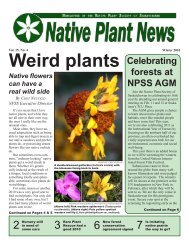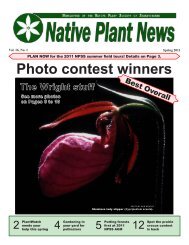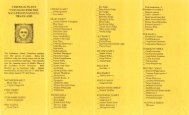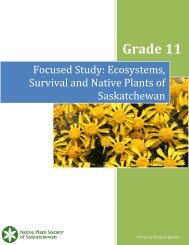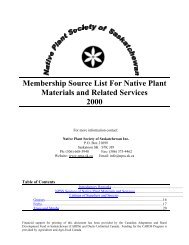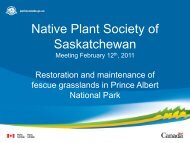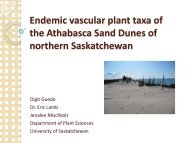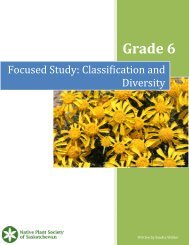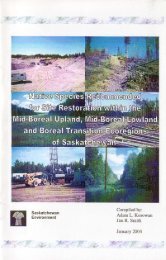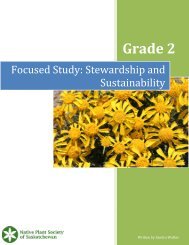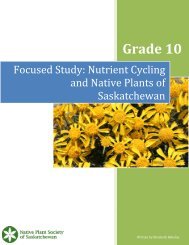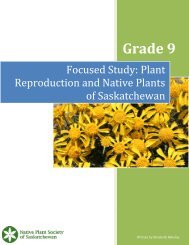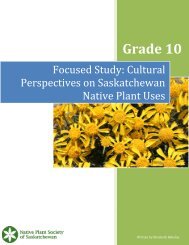Native Plants As Habitat For Wildlife - Native Plant Society of ...
Native Plants As Habitat For Wildlife - Native Plant Society of ...
Native Plants As Habitat For Wildlife - Native Plant Society of ...
You also want an ePaper? Increase the reach of your titles
YUMPU automatically turns print PDFs into web optimized ePapers that Google loves.
Use:<br />
Depending on their size and form, junipers are used as foundation plantings, screening,<br />
massed as ground covers or understories to hold difficult slopes or banks, or in a rock<br />
garden. The berry-like cones add to their landscape value. They provide cover and food<br />
for birds which <strong>of</strong>ten act as dispersal agents for the seed.<br />
Propagation:<br />
Cuttings or seeds. Seeds may take 2 years to germinate and should be stratified at 40C for<br />
3 months. Most cultivars are grafted. Branch tips are easily layered. Stem cuttings may be<br />
rooted.<br />
Pinus (pines):<br />
Pines grow naturally on light sandy soils and are well suited the prairie xeriscape. Their<br />
needles, in bundles <strong>of</strong> 2, 3 or 5, and triangular in cross-section, are arranged spirally on<br />
the whorled branches. Male and female cones are on the same tree. The male cones are<br />
found on young shoots at the base<br />
<strong>of</strong> the tree and disintegrate after releasing pollen. When transplanting pines ensure that<br />
the root ball <strong>of</strong> soil is left intact. Exposing the tiny root hairs to air and sun more <strong>of</strong>ten<br />
than not dooms the transplant to failure. Pines provide food and cover for birds and other<br />
wildlife species.<br />
Pinus banksiana (Jack pine)<br />
Description:<br />
The botanical species name honors Sir Joseph Banks, the noted British horticulturist.<br />
<strong>Native</strong> to the northern forests they are the most widely distributed pine in Canada. To the<br />
early European settlers, jack pines signalled poor soil and unsuitable farmland. When<br />
grown in the open, they are typically gnarled and twisted with a broad open form like a<br />
"Group <strong>of</strong> Seven" painting. In the forest they tend to be straighter due to competition with<br />
other trees. They reach up to 12 m and can live 150 years.<br />
Needles are sharp-pointed, dark green to yellowish-green, in bundles <strong>of</strong> two but spread<br />
apart within the bundle. The ends <strong>of</strong> the cones point forward to the ends or tips <strong>of</strong> the<br />
branches, are <strong>of</strong>ten curved and appear in clusters <strong>of</strong> two or three. The cones have no<br />
prickles. Most remain closed and will persist on the tree for ten or twenty years until<br />
triggered by the heat <strong>of</strong> fire or direct<br />
sunlight.<br />
The root system is wide spreading, and fairly deep, usually with a tap root. When their<br />
ranges overlap, jack pine will hybridize with lodge pole pines.<br />
Culture:<br />
39



